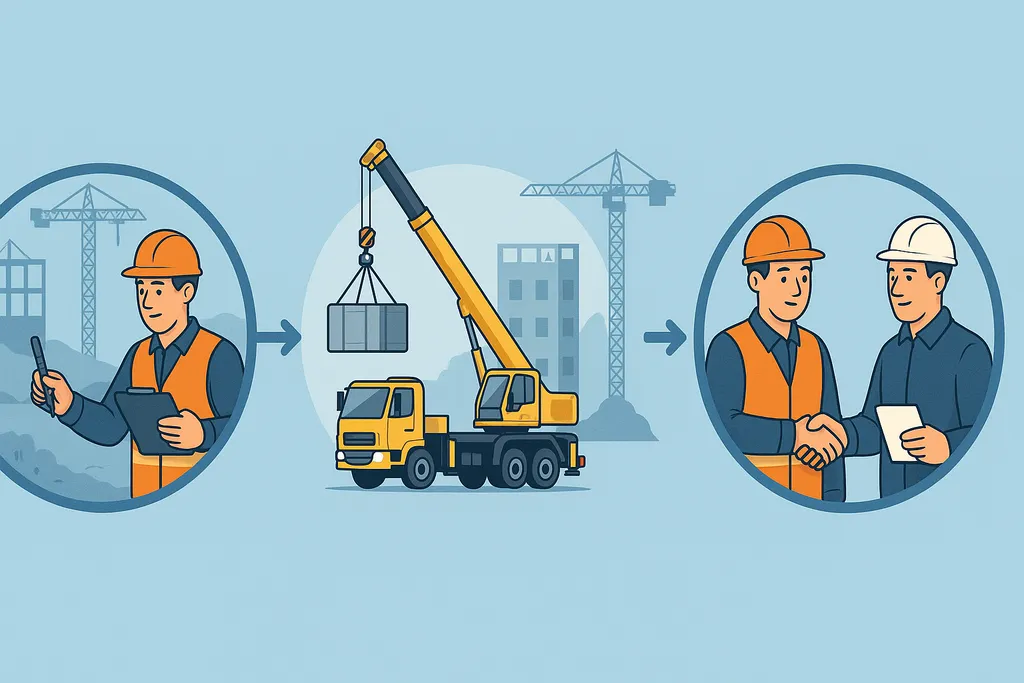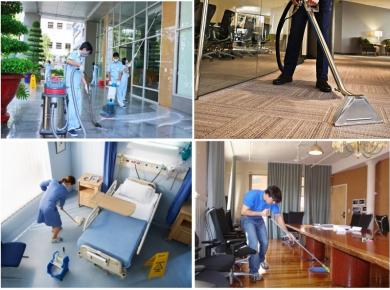Renting a crane is not just about choosing the right lifting capacity or negotiating a cheap price. To ensure safe operations, stay on schedule, and avoid unexpected expenses, you need a clear understanding of the process, legal compliance, and safety standards at the jobsite. This article summarizes hands-on experience from Phương Gia Foundation, helping you understand every step in a professional crane rental process, how to control risks, and strategies to optimize your project budget while ensuring safe and efficient lifting operations.

What is Crane Rental and When Do You Need Professional Crane Services?
Crane rental provides lifting equipment together with experienced operators to safely move heavy cargo, steel structures, containers, industrial machinery, or construction materials. In a competitive industrial and construction market, choosing the right crane type ensures cost savings and minimizes safety risks. Below is practical guidance to help you identify when to use a small truck-mounted crane or a heavy-duty all-terrain crane.
Truck-Mounted Crane and Real-World Applications
Truck-mounted cranes are vehicles equipped with a crane attached to the chassis. They are highly mobile, suitable for narrow urban streets, and ideal for loads from 1–10 tons such as air compressors, electrical cabinets, steel frames, or finishing materials. These cranes are perfect for rapid installation tasks across multiple job sites in the same day.
- Optimal for small to medium-sized projects, especially in Ho Chi Minh City and nearby industrial zones.
- Minimal setup time compared to large cranes.
- Cost-effective — priced per trip or per shift with lower total budget.
All-Terrain / Heavy-Duty Cranes
All-terrain cranes have high lifting capacity and long booms, commonly used in erecting steel structures, lifting silos, placing large CNC machines, or infrastructure construction. These cranes require a solid jobsite surface for outrigger deployment and may involve temporary traffic control depending on the lifting area.
- Perfect for heavy loads, long reach, and precise installation.
- Typically charged per operating shift with technical supervisors included.
- Pre-lift surveys required to confirm working angles, radius, and ground bearing capacity.
Professional Crane Rental Process from Survey to Handover
A well-managed crane rental process ensures safe execution, prevents delays, and avoids disputes over additional costs. Understanding each step below will help you control timelines, rental expenses, and on-site responsibility.
Step 1: Collect Cargo Information and Site Conditions
Before dispatching a crane, the technical team gathers key information to recommend the correct equipment:
- Weight and dimensions of each cargo unit (e.g., 4-ton transformer, 2.1m height, high tipping risk).
- Final placement location: ground level, mezzanine, rooftop, or onto another truck.
- Site access: narrow alleys, weak flooring, parking basement, noise-restricted zones, peak traffic time.
- Whether the lift requires reaching over obstacles or through narrow gaps.
Incorrect weight or hidden hazards often result in costly last-minute crane upgrades or added safety requirements.
Step 2: Site Survey (Direct or via Images/Video)
Site surveys are critical for a safe crane operation. For complex lifts — such as rooftop equipment installation — a physical inspection is required. For standard lifts, photos/videos with accurate measurements may suffice.
- Ground condition: can it support outrigger load?
- Obstacles: powerlines, roof edges, signage, balconies.
- Vehicle maneuverability: turning radius and setup space.
Proper surveys help prevent common incidents like ground collapse, crane tilting, or collisions that cause project shutdowns and financial claims.
Step 3: Lifting Plan & Detailed Quotation
Once surveyed, reputable providers of cost-effective crane rental propose the safest and most economical plan with a clear scope of work.
- Crane type and lifting capacity (e.g., 3-ton truck-mounted crane or 25-ton all-terrain crane).
- Work duration — per task or per 4/8-hour shift.
- Scope — lifting only or including positioning, leveling, and support blocks.
- Transportation fee to/from the jobsite.
- Surcharges — night work, weekends, traffic permit requirements.
Cost-saving tip: combine lifting tasks into a single shift instead of multiple mobilizations.
Step 4: Jobsite Preparation Before Crane Arrival
Many delays are caused by an unprepared jobsite, not late crane arrival. Preparation ensures safe operations and avoids paid waiting time.
- Clear access paths — remove obstacles like scrap or idle forklifts.
- Restrict access and protect surrounding workers.
- Prepare placement blocks: timber, rubber pads, suitable pallets.
- Ensure lighting and power for night work.
Urban lifts involving public streets may require temporary traffic control and safety observers.
Step 5: Lifting Operations by Certified Personnel
The skilled crane operator and signalman play a crucial role in maintaining load stability and preventing property damage.
- Deploy outriggers, level the crane, verify load chart compliance.
- Use rated slings, chains, and shackles — reject damaged gear.
- Execute lift safely using agreed-upon hand and radio signals.
- Complete delivery report confirming correct placement and undamaged goods.
For valuable machinery such as CNC systems or electrical cabinets, the crew often assists with positioning to the exact coordinate lines marked beforehand.
Step 6: Handover and Completion Report
Both parties sign documentation confirming time spent, lifting results, and any deviations from the original plan. These records are essential for billing and liability clarification.
- Take before-/after-photos.
- Record changes from the approved plan.
- Ensure no equipment or materials remain onsite.
Where to Rent Cranes for Both Safety and Cost Savings?
When choosing a crane rental service, price should not be the only factor. You should prioritize partners with proven experience in environments similar to your project (tight urban spaces, active factories, limited height zones, etc.). This ensures lower risk, fewer delays, and minimized damage to valuable equipment. Professional coordination between crane crews and installation teams helps avoid downtime costs.
Practical Experience and Capability Profile
Ask for real examples of similar lifting jobs instead of only photos of cranes parked at a yard. A trustworthy provider will explain why a specific crane type was chosen, why outrigger setup matters, and how they secure the lifting zone. Such detailed knowledge proves they truly understand safe crane operations. Many businesses prefer consistent cooperation with Phương Gia Foundation due to reliable availability, trained operators, and stable performance that reduces overall project costs.
- Certified operators and designated signalmen.
- Clear agreements on responsibilities for accidental damage.
- Flexible crane fleet sizing adapted to real jobsite constraints.
FAQ
Common questions when companies need a safe and cost-efficient crane rental for construction and industrial operations:
Does a crane rental include the operator?
Yes. Professional crane rental always includes a certified operator and support crew. Unauthorized personnel are not allowed to operate cranes due to high safety and legal risks.
Do I need a site survey just for lifting a 2-ton machine?
Yes, even if done via photos/video. Access width, outrigger placement, and lifting angles affect both safety and pricing. Narrow alleys or rooftop lifts may require a different crane specification.
Can the crane crew help position machinery accurately?
Usually yes. In factory setups, crane teams often place machines directly onto marked installation lines to streamline commissioning work.
Are blocking and leveling services included in crane rental costs?
Not always. Tasks such as positioning, leveling, and installing support pads may be counted as additional services — confirm specifics in the quotation to avoid misunderstandings.
Is there a surcharge for night work in city centers?
Often yes. Night work helps avoid traffic issues but requires extra safety measures such as lighting and traffic control — reflected in the pricing.
Conclusion & Contact
To rent cranes effectively, evaluate the entire process: accurate surveys, a clear lifting plan, certified operators, and a strong safety commitment. Working with experienced partners helps avoid costly delays and equipment damage while optimizing project expenses. Whether you are lifting heavy machinery, steel structures, or equipment into a new facility, choose a reliable provider with rapid response in your area. For crane rental services in Ho Chi Minh City and nearby provinces, please contact Phương Gia Foundation – Hotline: 0948952024 or 0824 255 5855 for fast and safe support.














